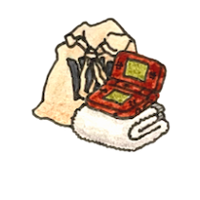
2024年1月26日
Yokubo Osechi
For Japanese people, the New Year’s holiday, called Oshogatsu, is generally considered to be the most important holiday of the year. It’s a time when people go back to their home towns to spend time with their families and observe various traditions, such as otoshidama (gifts of money), nengajo (New Year’s post cards), and hatsumode (the first shrine visit of the new year). Another such tradition is called osechi, and last New Year's Eve my friend and I challenged ourselves to partake in it in our own special way.
What is Osechi?
Osechi is an assortment of traditional foods eaten around the New Year’s holidays, usually beautifully arranged in square stacking lacquerware containers called jubako. The foods included in osechi each carry some meaning related to bringing in luck for the new year; Shrimp represent living a long life, as the curved back of a shrimp resembles the hunched-over back of an old man or woman. Kobumaki, sliced dried fish wrapped in seaweed, is a play on yorokobu, the Japanese word for happiness. Kuri-kinton, mashed sweet potatoes with chestnuts, can be written with the kanji for gold (金), and as such is associated with gold and prosperity. The list of osechi foods goes on.

A typical osechi arrangement (source: NHK)
Yokubo Osechi
Last month in my Japanese language class, as the new year approached, our teacher shared with us an article from NHK about a new trend in the way people eat osechi. The article talks about how these days, while many Japanese people still keep up the osechi tradition, not everyone is so fond of it. Many people find that the old-fashioned foods in osechi don’t suit their modern tastes. Others just wish they could choose for themselves what they eat rather than being pressured by tradition. To that end, some people have started creating their own original osechi according to their own tastes, called yokubo osechi, “yokubo” meaning appetite or desire. Yokubo osechi maintains the tradition of holding a feast with your loved ones and eating foods that represent good luck for the new year. But unlike with traditional osechi, with yokubo osechi you can choose for yourself what foods to include and what they represent. Examples given in the article include sute-ki (steak) for a suteki (wonderful) year, a taruto (tart) for michitaru-toki (being content, wanting for nothing), and miso cream cheese for someone entering their 30s (miso).
A Last-Minute Idea
Eventually New Year’s Eve came around. My friend and fellow classmate decided to stay in and celebrate at my place, keeping it small with some takeout, board games, and Kokuhaku Uta Gassen (the annual Japanese New Year’s TV program). That afternoon, as I finished up at the cafe I work at and my friend and I started talking about what food to pick up for dinner that night, I had an idea. I asked her if she remembered that article we read in class about yokubo osechi and if she’d like to try making our own for dinner that night. My friend agreed that that would be fun. We soon met up in Shibuya and set to work gathering everything we would need.
A Disclaimer
Before I continue, I want to be forthright with the fact that this was a last-minute idea, and that I possess no culinary skills. So by “making” osechi I really mean “picking out foods at the grocery store and arranging them nicely in a box”. Furthermore, keep in mind that this is a modern twist on an old tradition. Although the idea was introduced to us by our Japanese teacher and the article talks about how this trend is growing lately, many Japanese people would still probably still find the following to be strange. And with that out of the way, allow me to continue.
Making Our Yokubo Osechi
My friend and I first went to Daiso, the 100 yen shop, to look for the containers to put the food in. Osechi seems to almost always come in square containers, so that was a must. While we didn’t find the faux-lacquerware plastic square containers I was imagining, we did find some square Tupperware containers, so we settled for those. Next we picked up some cupcake liners to use as dividers. The shop had a small New Year’s section, and from there we grabbed a pack of omikuji (fortune) chopsticks, where each pair of chopsticks’ paper sleeve comes with a fortune printed on the inside.
Next was the most important step - choosing foods with meaning. Some of the things we came up with were: Kare (curry)-flavored rice crackers to wish for a kareshi (partner). Piza manju (pizza steamed bun) to wish for a smooth process with our biza (visas), since both of us are currently students and will soon need to apply for working visas. Gold chocolate coins for, obviously, financial fortune. And gyoza (dumplings), because some of our classmates from China talked about it being a common food to eat for good luck for the new year in China.
Back at my place, we put Kokuhaku Uta Gassen on the TV and arranged our osechi. This was the end result...

While our osechi may pale in comparison to the real thing - visually, culinarily, and nutritionally - for us this was a fun way to spend New Year's Eve. As foreigners living in Japan, it was the first time for either of us to experience osechi (or something like it). And as Japanese language students, trying to rack our brains to come up with food puns using our limited vocabulary was a fun challenge. So to anyone out there in a similar situation - a foreigner living in Japan, studying Japanese, and/or a picky eater - consider starting a new tradition with yokubo osechi.

References
-
好きなもの詰めていいんです | NHK
https://www3.nhk.or.jp/news/html/20221214/k10013921601000.html -
おせち料理の種類とそれぞれの意味。定番の中身はなに? | ぐるすぐり
https://gurusuguri.com/special/season/osechi/spcu-osechi_type/?__ngt__=TT14fb1fb47008ac1e4ae659JKMi3zn0U8Wak2C3EqZJCE






